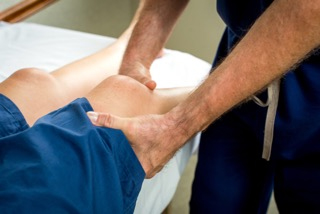Knees


Knee Anatomy
The knee is a complex joint made up of different structures including bones, tendons, ligaments and muscles. They all work together to maintain normal function and provide stability to the knee during movement.
For more information about Knee Anatomy, click on below tabs.
Knee Fracture
A fracture is a condition in which there is break in the continuity of the bone. In younger individuals these fractures are caused from high energy injuries, as from a motor vehicle accident. In older people the most common cause is weak and fragile bone.
For more information about Knee Fracture, click on below tabs.
Patellofemoral Instability
The knee can be divided into three compartments: patellofemoral, medial and lateral compartment. The patellofemoral compartment is the compartment in the front of the knee between the knee cap and thigh bone. The medial compartment is the area on the inside portion of the knee, and the lateral compartment is the area on the outside portion of the knee joint. Patellofemoral instability means that the patella (kneecap) moves out of its normal pattern of alignment. This malalignment can damage the underlying soft structures such as muscles and ligaments that hold the knee in place.
For more information about Patellofemoral Instability, click on below tabs.
Arthroscopy of the Knee Joint
Knee Arthroscopy is a common surgical procedure performed using an arthroscope, a viewing instrument, to look into the knee joint to diagnose or treat a knee problem. It is a relatively safe procedure and a majority of the patient’s discharge from the hospital on the same day of surgery.
For more information about Arthroscopy of the Knee Joint, click on below tabs.
Meniscus Repair
Meniscus is the C-shaped two pieces of cartilage located between thighbone and shin bone that act as shock absorbers and cushion the joints. Meniscus distributes the body weight uniformly across the joint and avoids the pressure on any one part of the joint and development of arthritis. Being the weight bearing part, meniscus is prone to wear and tear and meniscal tear is one of the common knee injuries. Meniscal tear may be developed by people of all ages and is more common in individuals who play contact sports.
For more information about Meniscus Repair, click on below tabs.
Total Knee Replacement (TKR)
Total knee replacement, also called total knee arthroplasty, is a surgical procedure in which the worn out or damaged surfaces of the knee joint are removed and replaced with artificial parts. The knee is made up of the femur (thigh bone), the tibia (shin bone), and patella (kneecap). The meniscus, the soft cartilage between the femur and tibia, serves as a cushion and helps absorb shock during motion. Arthritis (inflammation of the joints), injury, or other diseases of the joint can damage this protective layer of cartilage, causing extreme pain and difficulty in performing daily activities. Your doctor may recommend surgery if non-surgical treatment options have failed to relieve the symptoms.
For more information about Total Knee Replacement (TKR), click on below tabs.
Anterior Cruciate Ligament (ACL) Reconstruction
The anterior cruciate ligament is one of the major stabilizing ligaments in the knee. It is a strong rope like structure located in the center of the knee running from the femur to the tibia. When this ligament tears unfortunately, it does not heal and often leads to the feeling of instability in the knee.
ACL reconstruction is a commonly performed surgical procedure and with recent advances in arthroscopic surgery can now be performed with minimal incision and low complication rates.
ACL Reconstruction Hamstring Tendon
For more information about Anterior Cruciate Ligament (ACL) Reconstruction, click on below tabs.
ACL Reconstruction Patellar Tendon
For more information about ACL Reconstruction Patellar Tendon, click on below tabs.
Unicondylar Knee Replacement
Unicompartmental knee replacement is a minimally invasive surgery in which only the damaged compartment of the knee is replaced with an implant. It is also called a partial knee replacement. The knee can be divided into three compartments: patellofemoral, the compartment in front of the knee between the knee cap and thigh bone, medial compartment, on the inside portion of the knee, and lateral compartment which is the area on the outside portion of the knee joint.
For more information about Unicondylar Knee Replacement, click on below tabs.
Revision Knee Replacement
Revision knee replacement surgery involves replacing part or all of your previous knee prosthesis with a new prosthesis. Although total knee replacement surgery is successful, sometimes the procedure can fail due to various reasons and require a second revision surgery.
For more information about Revision Knee Replacement, click on below tabs.
Click on the topics below to find out more from the orthopedic connection website of American Academy of Orthopedic Surgeons.
- ACL Injury: Should it be fixed?
- Activities After a Knee Replacement
- Additional Resources on the Knee
- Adolescent Anterior Knee Pain
- Arthritis of the Knee
- Care of the Aging Knee: Baby Boomers May Need Lifestyle Changes
- Cemented and Cementless Knee Replacement
- Deep Vein Thrombosis
- Frequently Asked Questions about Osteoarthritis of the Knee
- Goosefoot (Pes Anserine) Bursitis of the Knee
- Knee Arthroscopy
- Knee Arthroscopy Exercise Guide
- Knee Implants
- Knee Replacement Exercise Guide
- Kneecap (Prepatellar) Bursitis
- Meniscal Tear
- Meniscal Transplants
- Minimally Invasive Total Knee Replacement
- Nonsurgical Treatment Options for Osteoarthritis of the Knee
- Orthopedists Research Female Knee Problems
- Osgood-Schlatter Disease (Knee Pain)
- Osteonecrosis of the Knee
- Posterior Cruciate Ligament (PCL) Tear
- Rotating Platform/Mobile-bearing Knees
- Runner’s Knee (Patellofemoral Pain)
- Surgical Treatment of Osteoarthritis of the Knee
- The Knee
- Total Knee Replacement
- Unstable Kneecap
- Viscosupplementation Treatment for Arthritis







